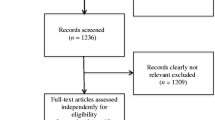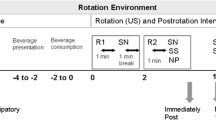Abstract
Background
Nocebo nausea is a debilitating and prevalent side effect that can develop after conditioning occurs between cues present in the treatment context and the experience of nausea. Interventions that retard conditioning may therefore be able to reduce nocebo nausea.
Purpose
To test whether ‘latent inhibition’, where pre-exposing cues in the absence of an outcome retards subsequent learning about those cues, could reduce nocebo nausea in healthy adults.
Methods
We examined this possibility using a Galvanic Vestibular Stimulation (GVS) model of nausea in healthy participants, with pre-exposure to the treatment cues achieved using a placebo version of GVS.
Results
In Experiment 1 we found clear evidence of conditioned nocebo nausea that was eradicated by latent inhibition following pre-exposure to placebo stimulation. Experiment 2 tested whether deception, which may be unethical in clinical settings, was necessary to produce latent inhibition by including an open pre-exposure group informed they were pre-exposed to placebo stimulation. Experiment 2 replicated the latent inhibition effect on nocebo nausea following deceptive pre-exposure from Experiment 1 and found that open pre-exposure was just as effective for reducing nocebo nausea. In both experiments, there was an interesting discrepancy found in expectancy ratings whereby expectations appeared to drive the development of conditioned nocebo nausea, but were not responsible for its suppression through latent inhibition.
Conclusions
These findings have significant clinical implications. Applying open pre-exposure in clinical settings may effectively and ethically reduce the development of nocebo effects for nausea and other conditions via latent inhibition.




Similar content being viewed by others
References
Bloechl-Daum B, Deuson RR, Mavros P, Hansen M, Herrstedt J. Delayed nausea and vomiting continue to reduce patients’ quality of life after highly and moderately emetogenic chemotherapy despite antiemetic treatment. J Clin Oncol. 2006; 24: 4472–4478.
Colagiuri B, Roscoe JA, Morrow GR, Atkins JN, Giguere JK, Colman LK. How do patient expectancies, quality of life and postchemotherapy nausea interrelate? Cancer. 2008; 113: 654–661.
Hilarius DL, Kloeg PH, van der Wall E, van den Heuvel JJG, Gundy CM, Aaronson NK. Chemotherapy-induced nausea and vomiting in daily clinical practice: A community hospital-based study. Support Care Cancer. 2012; 20: 107–117.
Davidson Q, Teleni L, Muller J, Ferguson M, McCarthy AL, Isenring E. Malnutrition and chemotherapy-induced nausea and vomiting: Implications for practice. Oncol Nurs Forum. 2012; 39: 340–345.
Colagiuri B, Zachariae R. Patient expectancy and post-chemotherapy nausea: A meta-analysis. Ann Behav Med. 2010; 40: 3–14.
Quinn VF, Colagiuri B. Placebo interventions for nausea: A systematic review. Ann Behav Med. 2015; 49: 449–462.
Barsky AJ, Saintfort R, Rogers MP, Borus JF. Nonspecific medication side effects and the nocebo phenomenon. JAMA. 2002; 287: 622–627.
Colagiuri B, Schenk LA, Kessler MD, Dorsey SG, Colloca L. The placebo effect: From concepts to genes. Neuroscience. 2015; 307: 171–190.
Klosterhalfen S, Kellermann S, Braun S, Kowalski A, Schrauth M, Zipfel S, Enck P. Gender and the nocebo response following conditioning and expectancy. J Psychosom Res. 2009; 66: 323–328.
Quinn VF, MacDougall HG, Colagiuri B. Galvanic vestibular stimulation: A new model of placebo-induced nausea. J Psychosom Res. 2015; 78: 484–488.
Bovbjerg DH, Redd WH, Jacobsen PB, Manne SL, Taylor KL, Surbone A, Crown JP, Norton L, Gilewski TA, Hudis CA, Reichman BS, Kaufman RJ, Currie VE, Hakes TB. An experimental analysis of classically conditioned nausea during cancer chemotherapy. Psychosom Med. 1992; 54: 623–637.
Lubow RE, Moore AU. Latent inhibition: The effect of nonreinforced pre-exposure to the conditional stimilus. J Comp Physiol Psychol. 1959; 54: 415–419.
Lubow RE. Latent inhibition. Psychol Bull. 1973; 79: 398–407.
Revusky SH, Bedarf EW. Association of illness with prior ingestion of novel foods. Science. 1967; 13: 219–220.
Hall G, Symonds M. Overshadowing and latent inhibition of context aversion conditioning in the rat. Auton Neurosci. 2006; 129: 42–49.
Holmes NM, Harris JA: Latent inhibition. In C. J. Mitchell and M. E. Le Pelley (eds), Attention and associative learning: From brain to behaviour. Oxford: Oxford University Press, 2010, 99–130.
Klosterhalfen S, Kellermann S, Stockhorst U, Wolf J, Kirschbaum C, Hall G, Enck P. Latent inhibition of rotation chair-induced nausea in healthy male and female volunteers. Psychosom Med. 2005; 67: 335–340.
Hall G, Stockhorst U, Enck P, Klosterhalfen S. Overshadowing and latent inhibition in nausea-based context conditioning in humans: Theoretical and practical implications. Q J Exp Psychol (Hove). 2015; 69: 1227–1238.
Andrykowski MA, Jacobsen PB, Marks E, Gorfinkle K, Hakes TB, Kaufman RJ, Currie VE, Holland JC, Redd WH. Prevalence, predictors and course of anticipatory nausea in women receiving adjuvant chemotherapy for breast cancer. Cancer. 1988; 62: 2607–2613.
Montgomery GH, Bovbjerg DH. Specific response expectancies predict anticipatory nausea during chemotherapy for breast cancer. J Consult Clin Psychol. 2001; 69: 831–835.
Mackintosh NJ. Overshadowing and stimulus intensity. Anim Learn Behav. 1976; 4: 186–192.
Quinn VF, Colagiuri B. Sources of placebo-induced relief from nausea: The role of instruction and conditioning. Psychosom Med. 2016; 78: 365–372.
Dilda V, MacDougall HG, Curthoys IS, Moore ST. Effects of galvanic vestibular stimulation on cognitive function. Exp Brain Res. 2012 275-285.
Kaptchuk TJ, Friedlander E, Kelley JM, Sanchez MN, Kokkotou E, Singer JP, Kowalczykowski M, Miller FG, Kirsch I, Lembo AJ. Placebos without deception: A randomized controlled trial in irritable bowel syndrome. PLoS One. 2010; 5: e15591.
Kirsch I. Response expectancy theory and application: A decennial review Appl Prev Psychol. 1997; 6: 69–79.
Lovibond PF, Shanks DR. The role of awareness in Pavlovian conditioning: Empirical evidence and theoretical implications. J Exp Psychol Anim Behav Process. 2002; 28: 3–26.
Le Pelley ME, Schmidt-Hansen M: Latent inhibition and learned irrelevance in human contigency learning. In R. E. Lubow and I. Weiner (eds), Latent inhibition: Cognition, neuroscience and applications to schizophrenia. Cambridge: Cambridge University Press, 2010.
Lubow RE, Kaplan O. The visual search analogue of latent inhibition: Implications for theories of irrelevant stimulus processing in normal and schizophrenic groups. Psychon Bull Rev. 2005; 12: 224–243.
Forrest DL, Mather M, Harris JA. Unmasking latent inhibition in humans. Q J Exp Psychol. 2016 10.1080/17470218.17472016.11249894.
Acknowledgements
V.F. Quinn was supported by an Australian Postgraduate Research Award. B. Colagiuri was supported by an Australian Research Council Discovery Early Career Research Award (DE160100864).
Author information
Authors and Affiliations
Corresponding author
Ethics declarations
Conflicts of Interest
The authors have no conflicts of interest to declare. Ethical standards set out by the declaration of Helsinki were adhered to. The project received ethical approval from the University of Sydney Human Research Ethics Committee, and all participants provided informed consent and were advised they could withdraw from the study at any time without repercussion.
About this article
Cite this article
Quinn, V.F., Livesey, E.J. & Colagiuri, B. Latent Inhibition Reduces Nocebo Nausea, Even Without Deception. ann. behav. med. 51, 432–441 (2017). https://doi.org/10.1007/s12160-016-9867-8
Published:
Issue Date:
DOI: https://doi.org/10.1007/s12160-016-9867-8




